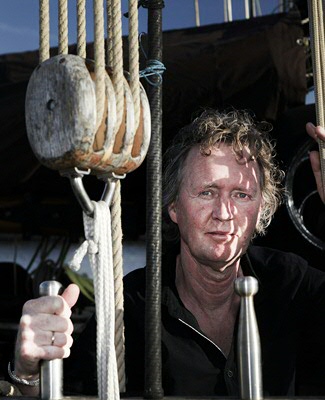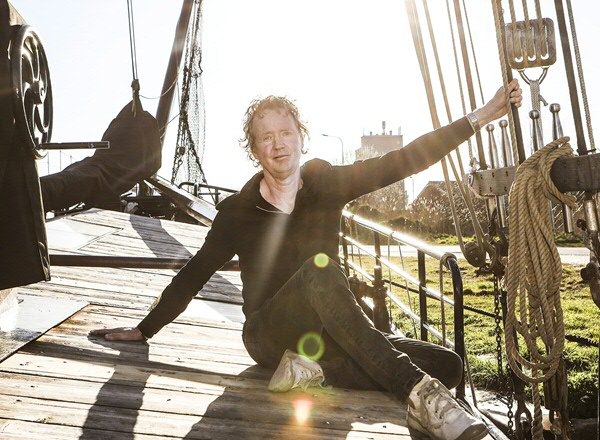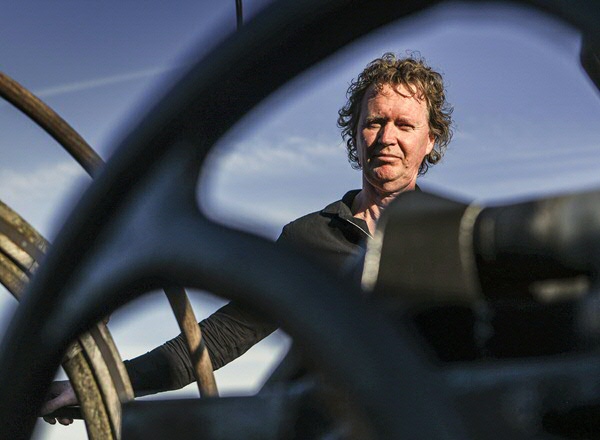Understanding the unpredictable

Researcher and keen sailor Wander Jager wants to understand all there is to know about human behaviour, influence and choices, and tipping points in public opinion. As humans are as unpredictable as it gets, his simulation models include every imaginable possibility so that he can make sense of the chaos.
Text: Eelco Salverda, Communication UG / Photos: Henk Veenstra
Wander Jager is interested in group behaviour. It is particularly useful to understand what happens in groups during periods of transition, protest and civil unrest. Jager is using models to conduct research into group behaviour at the University College Groningen. To his mind, this is the ideal method. The behaviour of large groups is difficult to study in real life. ‘You can hardly lock a thousand people per month in a lab to test different situations with them,’ he explains. ‘A computer simulation of behaviour is perfect for doing any experiments you want to, and repeating them hundreds of times if necessary. In addition, you can use models to link different situations to each other.’
The benefits of models
Of course, Jager knows that models are not infallible. The first problem is that the input partly determines the output. ‘All models are wrong, but some are useful,’ he quotes the statistician George Box. ‘Models are valuable because they allow you to generate realistic reflections of complex dynamic processes. What happens if this or that changes? You eventually gain a better understanding of how and why people react to certain interventions, and what makes a situation tip.’
Uncertain elements
Jager is a fervent sailor. You can just imagine him on the deck of a ship, mending a sail or tying a knot, with his longish hair, white sneakers, black jeans and shirt and bracelets. He even uses sailing and shipping jargon when explaining his work. ‘When you’re sailing, the situation is constantly uncertain. Anything can change: the wind, showers, the swell. Your response to these dynamics depends on how well you know the ship. It’s the same with models. You have to explore the options and respond accordingly.’

Fear of vaccines
Jager cites a few examples to make things more concrete. The Directorate-General for Public Works and Water Management asked him to analyse what would happen if in the future, we were all to be driven around by self-driving cars. ‘The consequences of such a situation would be enormous. For example, you wouldn’t need to have your own car on the drive because you could simply summon up a car whenever you needed one. So you could switch to car-sharing. In turn, this would affect mobility, living conditions in villages, even agriculture. So models allow you to understand the consequences of transition, even in the most complex systems. Or take COVID-19 vaccinations. Fear of the disease and the vaccination are spreading faster than the virus itself. A model can demonstrate people’s sensitivity to these rumours, and the influence they have on them.’
Not a crystal ball
Turbulence. This is a word that Jager uses regularly. He refers to the ‘butterfly effect’, which is used to describe small changes in a sensitive system that can have huge consequences. ‘Most behaviour is quite easy to predict. But not in turbulent situations within complex systems. This is where models come in.’ Although they are not crystal balls that can reveal the future, they are a mirror that can be used to show the dynamics of our behaviour.
Changing course together
Jager is interested in a lot of things, which is good because it means that he can include lots of different studies in his models. ‘I’ve got an opinion on practically everything. Energy transition, traffic, nutrition, landscape, health, migration. Someone once told me that I lacked focus. No I don’t, I replied. My focus is modelling social complexity. I use modelling to make links between insight and knowledge from different fields. When you’re sailing into the wind on a boat, you have to work together if you want to change course. You need one person for the sail, and another person at the helm. Cooperation is essential on a boat, but this is also true of research.’

Adrift
Although Jager sees himself as a social scientist, he is also very interested in natural sciences. The penny really dropped for him when he discovered that the chaos theory from natural science could also be used to explain social processes. ‘It’s all about the idea that fundamental unpredictability not only exists, but that you can also try to understand it. I find this utterly fascinating. Models show you how you can motivate people, they show the influence of leaders and status, of consultation evenings and of information in general. They show you just how important bottom-up principles can be as organizing principles. This is important to governments and the EU, particularly during transitions.’
Coloured balls
Even at the beginning of the interview, Jager could not wait to show off some of his simulations. So a bit later on, his laptop magically appeared. He showed me a simulation that revealed how newcomers integrate in the Netherlands, with circles that either stay on their own side of an imaginary line, or cross it. And then one that showed the effectiveness of permanent or transient teams of street cleaners, which munched up dirt like the original Pacman figures. Finally, he showed the sales and market share of three products, identical in terms of service, price and quality. Blue, red and green balls shot randomly across the screen like atoms, before forming clusters per colour. ‘Look how sales of the blue product increase if I increase the status of the blue product, even if the blue product scores lower on service, quality and price. This is an example of a social lock-in. People keep doing what they’ve always done, because other people are doing it too.’
Understanding the unpredictable
Jager can see potential applications for his simulations everywhere. If he hadn’t arranged a band rehearsal (another one of his hobbies), the interview would have gone on all day. Before leaving, he quickly recapped his message: ‘I’m the skipper who wants to find out exactly when a situation will start to change. I want to be able to predict when things will become unpredictable.’ At midnight, I’m alerted to another email from him. It’s about the lectures he is giving, a transition game, a free online course (MOOC) in computational social science that is due to start in July... It seems that Jager has not yet gone to bed. The skipper is doing his late-night rounds.
More information
More news
-
05 March 2025
Women in Science
